Improving GNSS PPP Convergence: The Case of Atmospheric-Constrained, Multi-GNSS PPP-AR
Abstract
:1. Introduction
2. Datasets Used and Data Processing Details
3. Concepts of Functional and Stochastic Atmospheric Constraints
3.1. Existing Atmospheric Products
3.1.1. Existing GIM Products
3.1.2. Zenith Path Delay Products
3.2. Methods of Constraint Application
4. Variations between Estimated Slant and GIM Delays
5. Dual- and Triple-Frequency Multi-GNSS PPP Atmospheric Constraining with AR
5.1. Dual-Frequency Analysis
5.2. Triple-Frequency Analysis
5.3. Dual-Frequency with GPS-AR Analysis
6. Conclusions and Future Work
- (1)
- What is the magnitude of improvements observed from the usage of traditional dual-frequency measurements to triple-frequency PPP processing with atmospheric constraints?Results presented show a significant level of improvement of more than 60% from atmospheric constrained dual- to triple-frequency multi-GNSS PPP in terms of the reduction in convergence time.
- (2)
- What are the inherent challenges when constraining PPP solutions with atmospheric corrections either functionally or stochastically?It was shown that caution needs to be taken when considering using GIM estimates and their uncertainties to constrain. To avoid under or over constraining, there is the need for, e.g., an adaptive method in the application of the constraints.
- (3)
- What is the significance of PPP-AR in multi-GNSS PPP atmospheric constrained solution?PPP-AR plays a vital role and enables an improved atmospheric-constrained solution. Results presented in this paper with GPS-AR show the greatest improvement at the 95th percentile.
- (4)
- Finally, what are the key challenges left in obtaining near-instantaneous PPP convergence akin to RTK data processing?With typical RTK convergence of 10 min, results presented show how close we are to near-instantaneous convergence. With improved atmospheric products, as well as orbits, clocks and bias estimation, PPP solution accuracy is bound to improve.
Author Contributions
Funding
Acknowledgments
Conflicts of Interest
References
- Kouba, J.; Héroux, P. Precise point positioning using IGS orbit and clock products. GPS Solut. 2001, 5, 12–28. [Google Scholar] [CrossRef]
- Zumberge, J.F.; Heflin, M.B.; Jefferson, D.C.; Watkins, M.M.; Webb, F.H. Precise point positioning for the efficient and robust analysis of GPS data from large networks. J. Geophys. Res. Solid Earth 1978–2012 1997, 102, 5005–5017. [Google Scholar] [CrossRef] [Green Version]
- Urquhart, L. An Analysis of Multi-Frequency Carrier Phase Linear Combinations for GNSS; Technical Report Issue 263; University of New Brunswick: Fredericton, NB, Canada, 2009. [Google Scholar]
- Li, J.; Yang, Y.; He, H.; Guo, H. An analytical study on the carrier-phase linear combinations for triple-frequency GNSS. J. Geod. 2017, 91, 151–166. [Google Scholar] [CrossRef]
- Henkel, P.; Günther, C. Reliable integer ambiguity resolution with multi-frequency code carrier linear combinations. J. Glob. Posit. Syst. 2010, 9, 90–103. [Google Scholar]
- Hofmann-Wellenhof, B.; Lichtenegger, H.; Wasle, E. GNSS–Global Navigation Satellite Systems: GPS, GLONASS, Galileo, and More; Springer Science & Business Media: Berlin/Heidelberg, Germany, 2007; Chapter 12; pp. 397–417. [Google Scholar]
- Wang, K.; Rothacher, M. Ambiguity resolution for triple-frequency geometry-free and ionosphere-free combination tested with real data. J. Geod. 2013, 87, 539–553. [Google Scholar] [CrossRef]
- Elsobeiey, M.; El-Rabbany, A. Effect of Second-Order Ionospheric Delay on GPS Orbit and Precise Point Positioning. In Proceedings of the 22nd International Technical Meeting of The Satellite Division of the Institute of Navigation (ION GNSS 2009), Savannah, GA, USA, 22–25 September 2009; pp. 2489–2495. [Google Scholar]
- Aggrey, J.; Bisnath, S. Analysis of Multi-GNSS PPP Initialization using Dual- and Triple-frequency Data. In Proceedings of the Proceedings of the 2017 International Technical Meeting of The Institute of Navigation, Monterey, CA, USA, 30 January–2 February 2017; pp. 445–458. [Google Scholar]
- Cueto, M.; Cezon, A.; Pineda, S.; Sardon, E. Ionospheric Analysis in the Equatorial Region: Impact on GNSS Performances. In Proceedings of the ION GNSS 20th International Technical Meeting of the Satellite Division, Fort Worth, TX, USA, 25–28 September 2007; pp. 25–28. [Google Scholar]
- Rovira-Garcia, A.; Juan, J.M.; Sanz, J. A Real-time World-wide Ionospheric Model for Single and Multi-frequency Precise Navigation. In Proceedings of the 27th International Technical Meeting of the Satellite Division of the Institute of Navigation (ION GNSS+ 2014), Tampa, FL, USA, 8–12 September 2014; pp. 2533–2543. [Google Scholar]
- Odijk, D. Fast Precise GPS Positioning in the Presence of Ionospheric Delays. Ph.D. Thesis, Delft University of Technology, Delft, The Netherlands, 2002. Publications on Geodesy 52. [Google Scholar]
- Odijk, D. Ionosphere-free phase combinations for modernized GPS. J. Surv. Eng. 2003, 129, 165–173. [Google Scholar] [CrossRef]
- Teunissen, P.J.; Odijk, D.; Zhang, B. PPP-RTK: Results of CORS network-based PPP with integer ambiguity resolution. J. Aeronaut. Astronaut. Aviat. Ser. A 2010, 42, 223–230. [Google Scholar]
- Zhang, B.; Teunissen, P.J.G.; Odijk, D. A Novel Un-differenced PPP-RTK Concept. J. Navig. 2011, 64, S180–S191. [Google Scholar] [CrossRef]
- Tu, R.; Zhang, R.; Lu, C.; Zhang, P.; Liu, J.; Lu, X. A Unified Model for BDS Wide Area and Local Area Augmentation Positioning Based on Raw Observations. Sensors 2017, 17, 507. [Google Scholar] [CrossRef] [PubMed]
- Collins, P.; Lahaye, F.; Bisnath, S. External ionospheric constraints for improved PPP-AR initialisation and a generalised local augmentation concept. In Proceedings of the 25th International Technical Meeting of the Satellite Division of The Institute of Navigation (ION GNSS 2012), Nashville, TN, USA, 17–21 September 2012; pp. 3055–3065. [Google Scholar]
- Geng, J. Rapid Integer Ambiguity Resolution in GPS Precise Point Positioning. Ph.D. Thesis, University of Nottingham, Nottingham, UK, 2011. [Google Scholar]
- Li, X. Improving real-time PPP ambiguity resolution with ionospheric characteristic consideration. In Proceedings of the ION GPS, Nashville Convention Center, Nashville, TN, USA, 17–21 September 2012; pp. 3027–3037. [Google Scholar]
- Seepersad, G.G. Improving Reliability and Assessing Performance of Global Navigation Satellite System Precise Point Positioning Ambiguity Resolution. Ph.D. Thesis, York University, Toronto, ON, Canada, 2018. [Google Scholar]
- Banville, S. Improved convergence for GNSS Precise Point Positioning. Ph.D. Thesis, University of New Brunswick, Fredericton, NB, Canada, 2014. [Google Scholar]
- Collins, P.; Bisnath, S. Issues in ambiguity resolution for Precise Point Positioning. In Proceedings of the 24th International Technical Meeting of the Satellite Division of The Institute of Navigation (ION GNSS 2011), Portland, OR, USA, 20–23 September 2011; pp. 679–687. [Google Scholar]
- Lou, Y.; Zheng, F.; Gu, S.; Wang, C.; Guo, H.; Feng, Y. Multi-GNSS precise point positioning with raw single-frequency and dual-frequency measurement models. GPS Solut. 2016, 20, 849–862. [Google Scholar] [CrossRef]
- Yao, Y.; Zhang, R.; Song, W.; Shi, C.; Lou, Y. An improved approach to model regional ionosphere and accelerate convergence for precise point positioning. Adv. Space Res. 2013, 52, 1406–1415. [Google Scholar] [CrossRef]
- Liu, T.; Yuan, Y.; Zhang, B.; Wang, N.; Tan, B.; Chen, Y. Multi-GNSS precise point positioning (MGPPP) using raw observations. J. Geod. 2017, 91, 253–268. [Google Scholar] [CrossRef]
- Mervart, L.; Lukes, Z.; Rocken, C.; Iwabuchi, T. Precise Point Positioning with Ambiguity Resolution in Real-Time. In Proceedings of the ION GNSS, Savannah, GA, USA, 16–19 September 2008; Volume 8, pp. 16–19. [Google Scholar]
- Laurichesse, D.; Mercier, F.; Berthias, J.-P.; Broca, P.; Cerri, L. Integer ambiguity resolution on undifferenced GPS phase measurements and its application to PPP and satellite precise orbit determination. Navigation 2009, 56, 135–149. [Google Scholar] [CrossRef]
- Bertiger, W.; Desai, S.D.; Haines, B.; Harvey, N.; Moore, A.W.; Owen, S.; Weiss, J.P. Single receiver phase ambiguity resolution with GPS data. J. Geod. 2010, 84, 327–337. [Google Scholar] [CrossRef]
- Tobias, G.; Garcia, C.; Mozo, A.; Navarro, P.; Piriz, R.; Rodriguez, I.; Rodriguez, D. Filling in the gaps of RTK with Regional PPP. In Proceedings of the 24th International Technical Meeting of The Satellite Division of the Institute of Navigation (ION GNSS 2011), Portland, OR, USA, 20–23 September 2011; pp. 2193–2201. [Google Scholar]
- Aggrey, J.E. Multi-GNSS Precise Point Positioning Software Architecture and Analysis of GLONASS Pseudorange Biases. Master’s Thesis, York University, Toronto, ON, Canada, 2014. [Google Scholar]
- Seepersad, G. Reduction of Initial Convergence Period in GPS PPP Data Processing. Master’s Thesis, York University, Toronto, ON, Canada, 2012. [Google Scholar]
- Schaer, S.; Gurtner, W.; Feltens, J. IONEX: The ionosphere map exchange format version 1. In Proceedings of the IGS AC Workshop, Darmstadt, Germany, 9–11 February 1998; Volume 9. No. 11. [Google Scholar]
- Aggrey, J. Assessment of Global and Regional Ionospheric Corrections in Multi-GNSS PPP. In Proceedings of the 31st International Technical Meeting of The Satellite Division of the Institute of Navigation (ION GNSS+ 2018), Miami, FL, USA, 24–28 September 2018; pp. 3967–3981. [Google Scholar]
- Hackman, C.; Guerova, G.; Byram, S.; Dousa, J.; Hugentobler, U. International GNSS Service (IGS) Troposphere Products and Working Group Activities. In Proceedings of the FIG Working Week, Sofia, Bulgaria, 17–21 May 2015. [Google Scholar]
- Schuler, T. On ground-based GPS tropospheric delay estimation. Ph.D. Thesis, Stud. Geodsie Geoinformation University of Buundeswehr Munchen, Munich, Germany, 2001. [Google Scholar]
- Lu, C.; Chen, X.; Liu, G.; Dick, G.; Wickert, J.; Jiang, X.; Zheng, K.; Schuh, H. Real-Time Tropospheric Delays Retrieved from Multi-GNSS Observations and IGS Real-Time Product Streams. Remote Sens. 2017, 9, 1317. [Google Scholar] [CrossRef]
- Xu, Y.; Wu, C.; Li, L.; Yan, L.; Liu, M.; Wang, S. GPS/BDS Medium/Long-Range RTK Constrained with Tropospheric Delay Parameters from NWP Model. Remote Sens. 2018, 10, 1113. [Google Scholar] [CrossRef]
- Byun, S.; Bar-Sever, Y. The Re-Analysis of the IGS Tropospheric Product. In Proceedings of the IGS Workshop, Newcastle, UK, 28 June–1 July 2010; Available online: http://acc.igs.org/tropo/tropo-repro_IGSW10.pdf (accessed on 12 December 2018).
- Gendt, G. IGS combination of tropospheric estimates–experience from pilot experiment. In Proceedings of the 1998 IGS Analysis Center Workshop, Darmstadt, Germany, 9–11 February 1998; Dow, J.M., Kouba, J., Springer, T., Eds.; IGS Central Bureau, Jet Propulsion Laboratory: Pasadena, CA, USA, 1998; pp. 205–216. [Google Scholar]
- Øvstedal, O. Absolute positioning with single-frequency GPS receivers. GPS Solut. 2002, 5, 33–44. [Google Scholar] [CrossRef]
- Schaer, S.; Géodésique, S. helvétique des sciences naturelles C. In Mapping and Predicting the Earth’s Ionosphere Using the Global Positioning System; Institut für Geodäsie und Photogrammetrie, Eidg. Technische Hochschule Zürich: Zürich, Switzerland, 1999; Volume 59. [Google Scholar]
- Aggrey, J.; Bisnath, S. Performance Analysis of Atmospheric Constrained Uncombined Multi-GNSS PPP. In Proceedings of the 30th International Technical Meeting of the Satellite Division of the Institute of Navigation (ION GNSS+ 2017), Portland, OR, USA, 25–29 September 2017; pp. 2191–2203. [Google Scholar]
- Seepersad, G.; Aggrey, J.; Bisnath, S. Do We Need Ambiguity Resolution in Multi-GNSS PPP for Accuracy or Integrity? In Proceedings of the 30th International Technical Meeting of The Satellite Division of the Institute of Navigation (ION GNSS+ 2017), Portland, OR, USA, 25–29 September 2017; pp. 2204–2218. [Google Scholar]

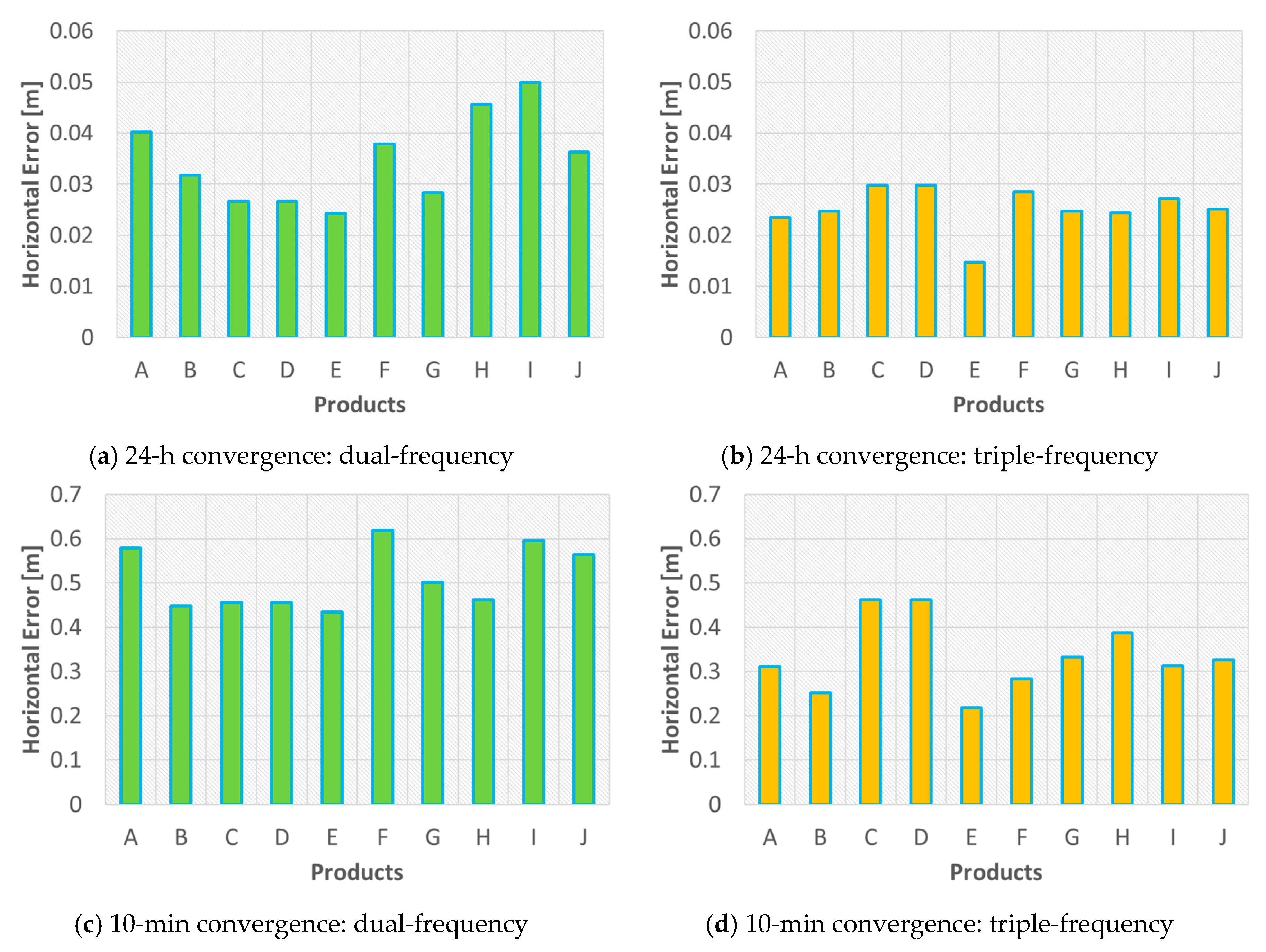




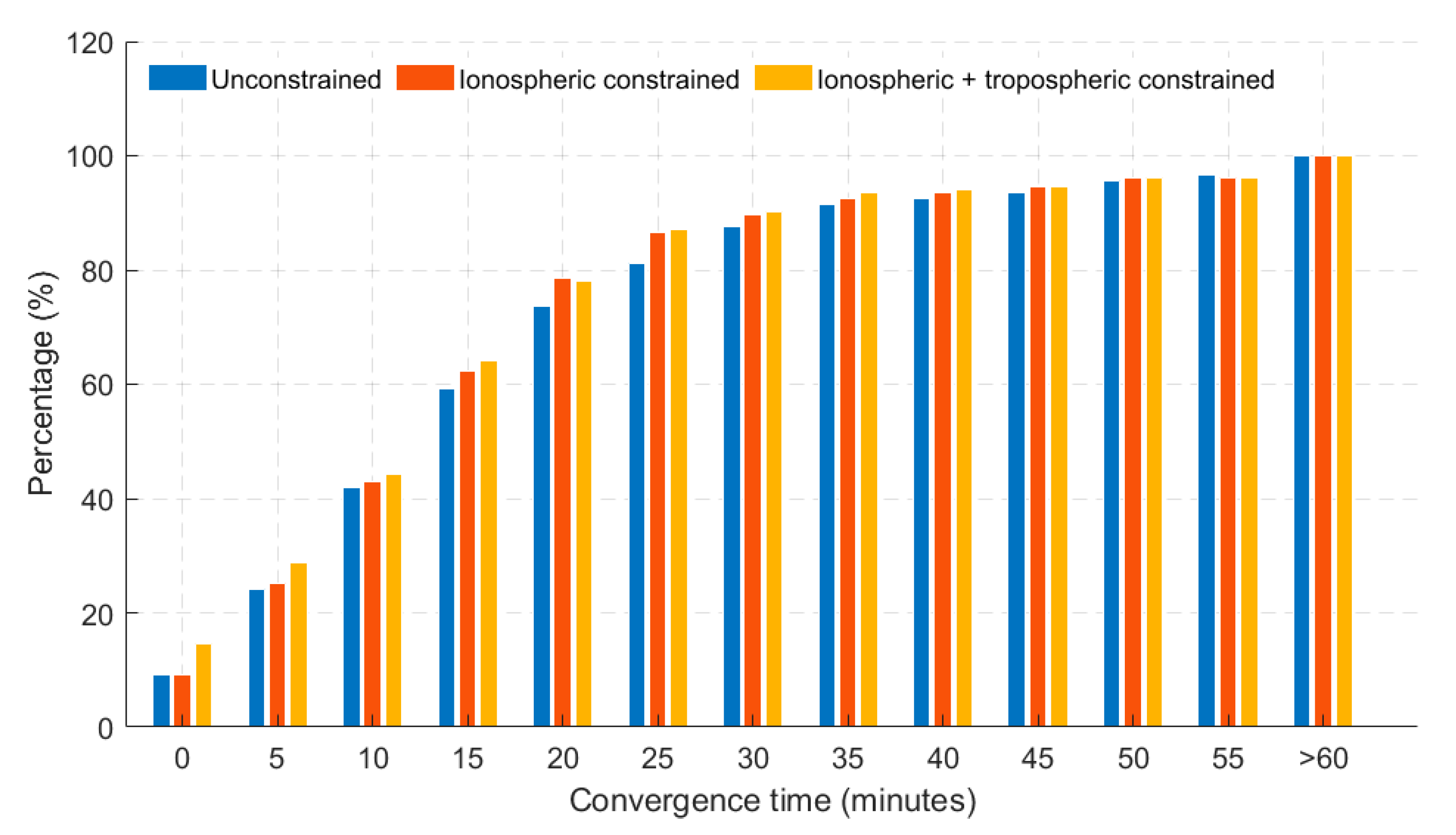
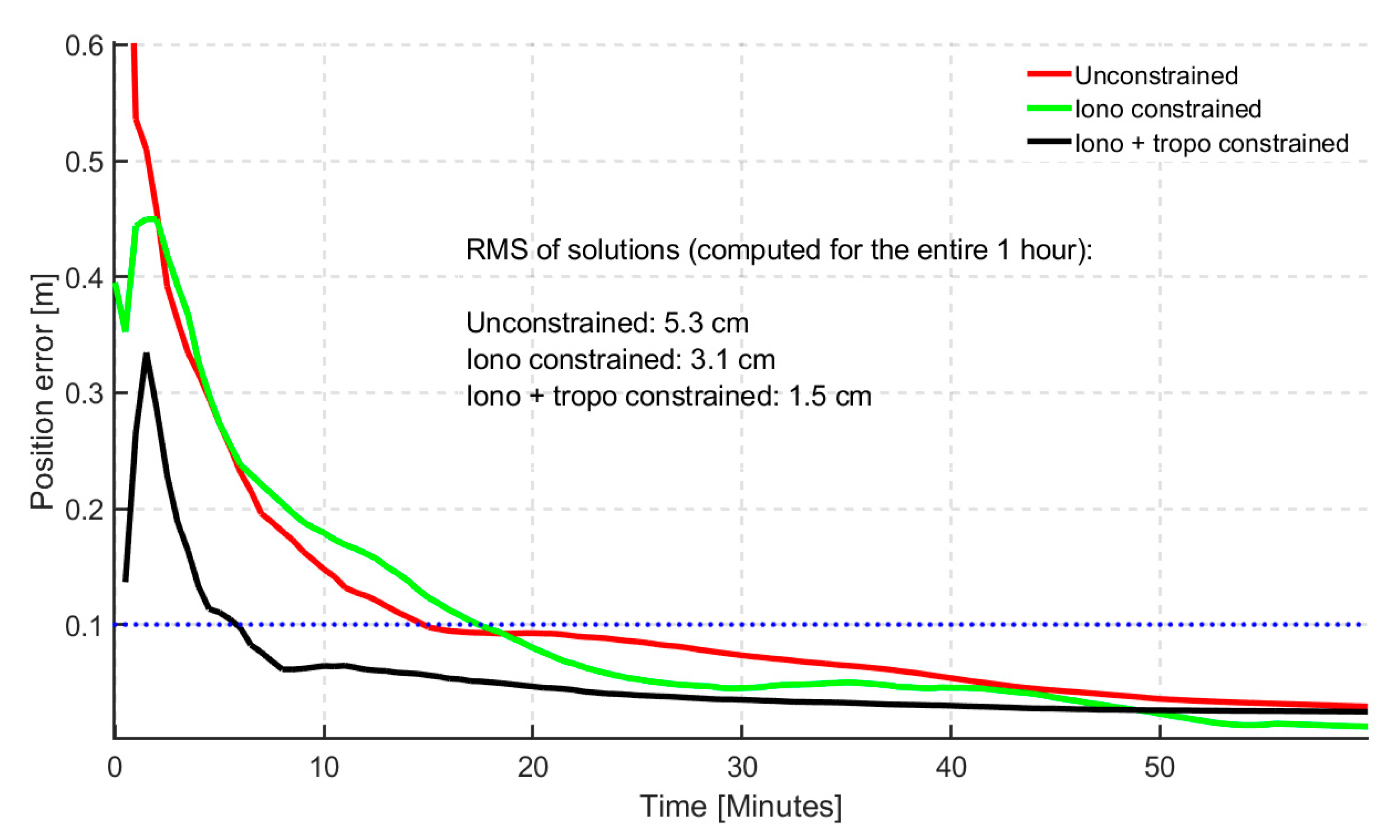
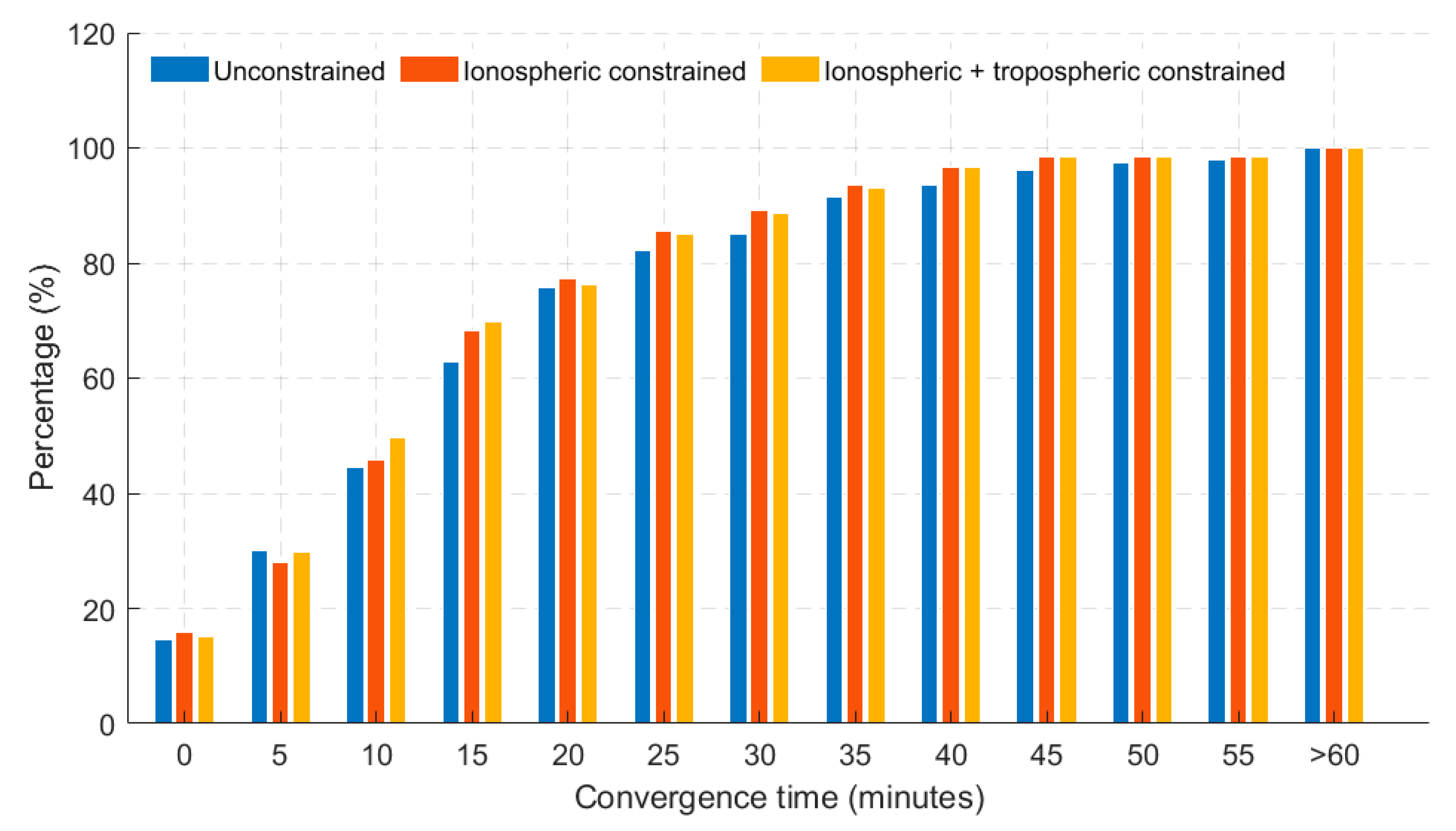

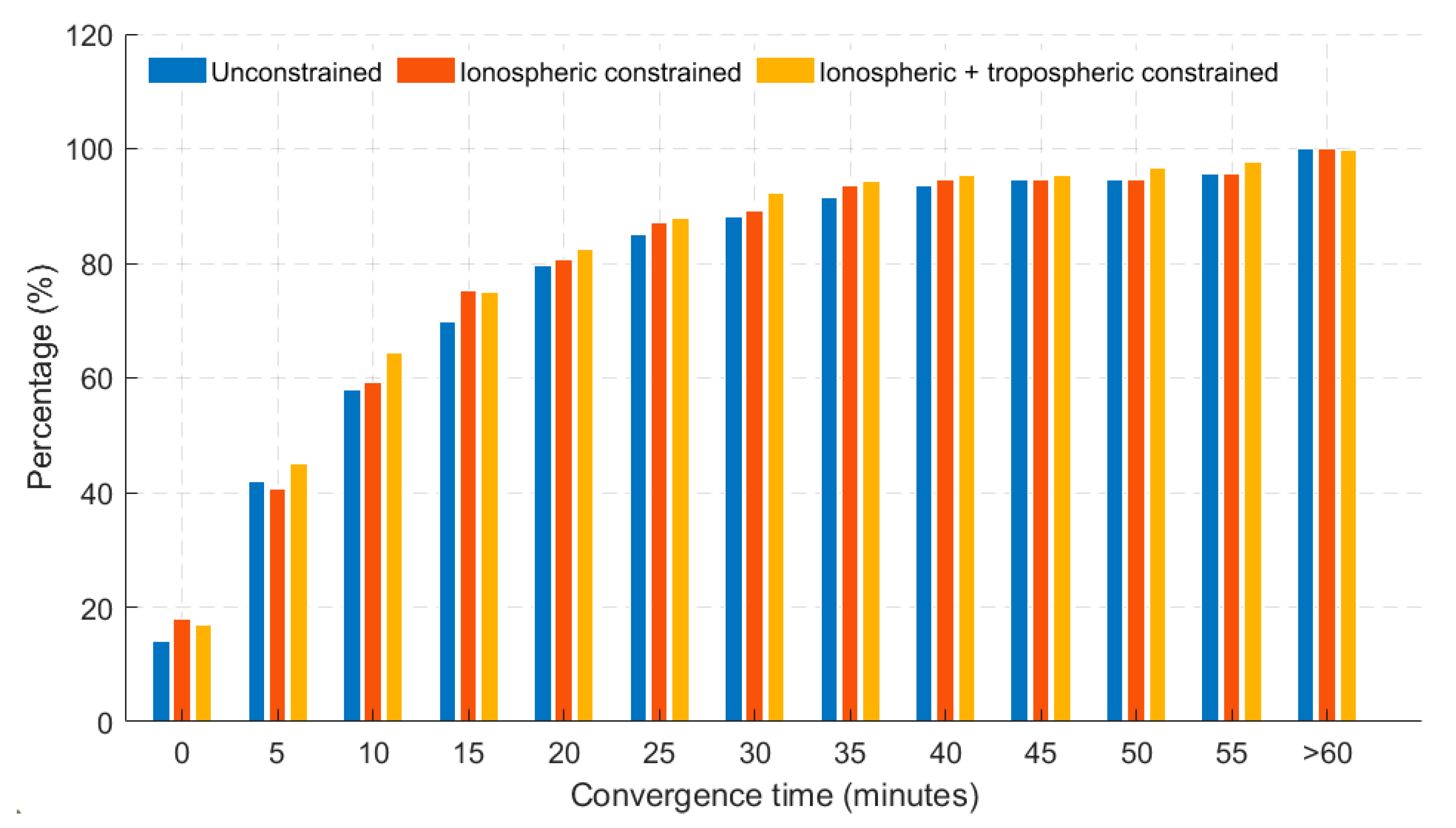
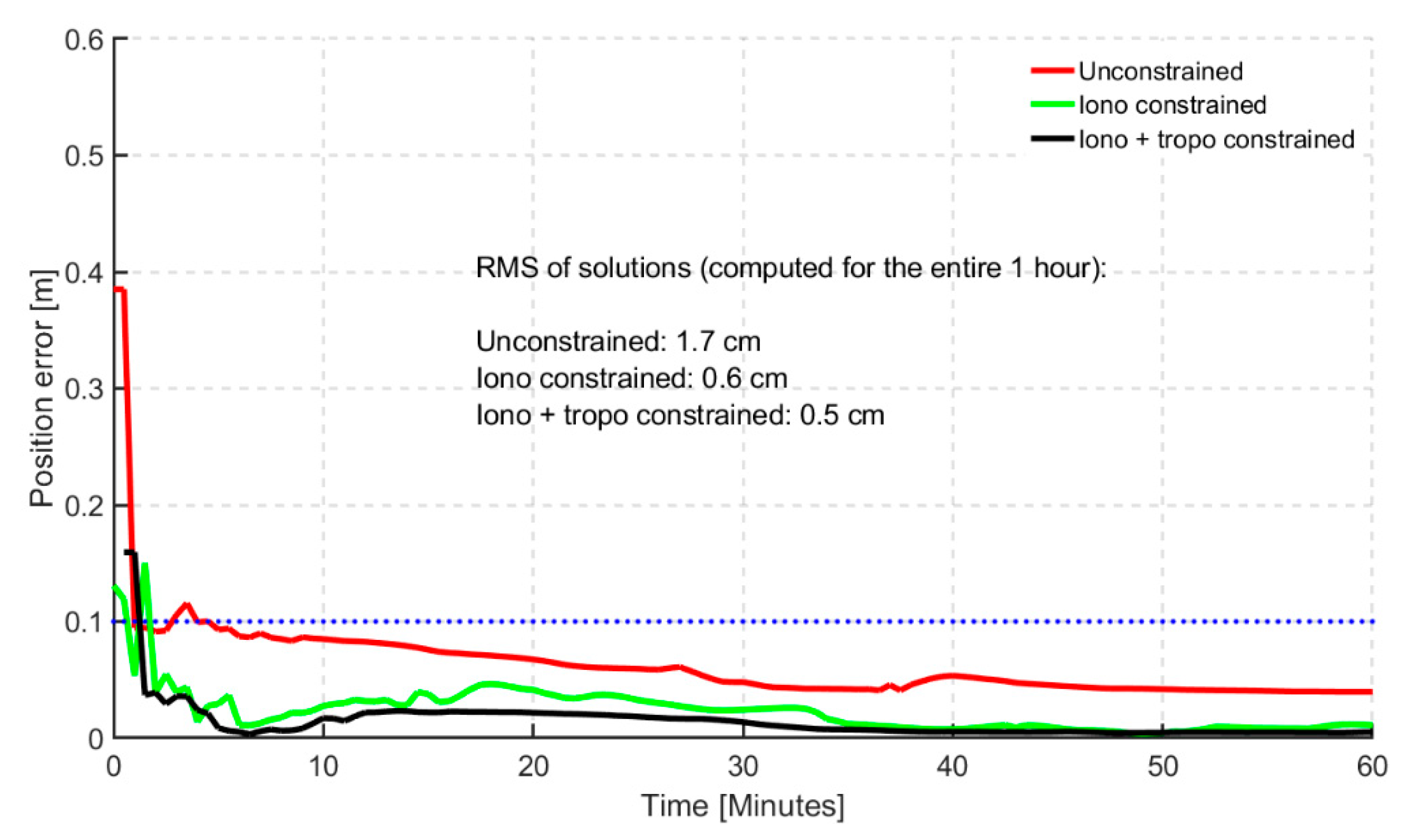
| Processing Parameters | YorkU GNSS PPP Engine Settings |
|---|---|
| Processing technique | Uncombined mode using raw strength of observations |
| Antenna corrections | IGS ANTEX |
| Satellite orbits and clocks | GBM (GFZ) |
| Elevation mask | Minimal 10° |
| GNSS system | GPS, GLONASS, Galileo and BeiDou |
| Observation processing mode | Dual-frequency, Triple-frequency, GPS ambiguity resolution, static processing |
| Data format | RINEX 2.× or 3.× |
| Ionospheric mitigation | Slant ionospheric delays: estimated GIM delays: used to constrain only the first epoch |
| Troposphere modelling | Hydrostatic delay: Davis (GPT) Wet delay: estimated Mapping function |
| Product | Agency | Type of Product | #Stations | #Satellites | GNSS | Mapping Function |
|---|---|---|---|---|---|---|
| c1pg | AIUB | 1-day predicted | ~120 | ~56 | *GNSS | NONE |
| c2pg | AIUB | 2-day predicted | ~120 | ~56 | *GNSS | NONE |
| carg | AOE | Post-processed (R) | -- | -- | *MIX | COSZ |
| casg | AOE | Post-processed (F) | -- | -- | *MIX | COSZ |
| codg | AIUB | Post-processed (F) | ~259 | ~56 | *GNSS | NONE |
| corg | AIUB | Post-processed (R) | ~118 | ~55 | *GNSS | NONE |
| e1pg | ESA/ESOC | 1-day predicted | -- | -- | GPS | NONE |
| e2pg | ESA/ESOC | 1-day predicted | -- | -- | GPS | NONE |
| ehrg | ESA/ESOC | Post-processed (R) | ~231 | ~54 | GPS | NONE |
| emrg | NRCAN | Post-processed (R) | ~351 | ~29 | GPS | MOD |
| esag | ESA/ESOC | Post-processed (F) | ~300 | ~54 | GPS | NONE |
| esrg | ESA/ESOC | Post-processed | ~236 | ~54 | GPS | NONE |
| igrg | IGS | Post-processed (CR) | ~296 | 0 | *MIX | COSZ |
| igsg | IGS | Post-processed (CF) | ~328 | ~32 | *MIX | COSZ |
| jplg | JPL | Post-processed (F) | ~170 | ~31 | GPS | NONE |
| jprg | JPL | Post-processed (R) | ~170 | ~31 | GPS | NONE |
| u2pg | UPC | Predicted | -- | -- | GPS | NONE |
| uhrg | UPC | Post-processed (R) | ~259 | ~31 | *MIX | COSZ |
| upcg | UPC | Post-processed (F) | ~272 | ~31 | GPS | NONE |
| uprg | UPC | Post-processed (R) | ~272 | ~31 | GPS | NONE |
| uqrg | UPC | Post-processed (R) | ~255 | ~31 | GPS | COSZ |
| whug | WHU | Post-processed (F) | ~314 | ~31 | GPS | MSLM |
| Processing Modes | Convergence in Minutes (Typical) | Convergence in Minutes (Achieved) |
|---|---|---|
| Dual-frequency PPP | 20 | 15 [9,42] |
| Triple-frequency PPP | 20 | 18 [9] |
| Dual-frequency atmospheric-constrained PPP | ~ | 6 |
| Triple-frequency atmospheric-constrained PPP | ~ | 2 |
| Dual-frequency PPP-AR | 15 | 11 [43] |
| Dual-frequency atmospheric-constrained PPP-AR | ~ | <2 |
© 2019 by the authors. Licensee MDPI, Basel, Switzerland. This article is an open access article distributed under the terms and conditions of the Creative Commons Attribution (CC BY) license (http://creativecommons.org/licenses/by/4.0/).
Share and Cite
Aggrey, J.; Bisnath, S. Improving GNSS PPP Convergence: The Case of Atmospheric-Constrained, Multi-GNSS PPP-AR. Sensors 2019, 19, 587. https://doi.org/10.3390/s19030587
Aggrey J, Bisnath S. Improving GNSS PPP Convergence: The Case of Atmospheric-Constrained, Multi-GNSS PPP-AR. Sensors. 2019; 19(3):587. https://doi.org/10.3390/s19030587
Chicago/Turabian StyleAggrey, John, and Sunil Bisnath. 2019. "Improving GNSS PPP Convergence: The Case of Atmospheric-Constrained, Multi-GNSS PPP-AR" Sensors 19, no. 3: 587. https://doi.org/10.3390/s19030587
APA StyleAggrey, J., & Bisnath, S. (2019). Improving GNSS PPP Convergence: The Case of Atmospheric-Constrained, Multi-GNSS PPP-AR. Sensors, 19(3), 587. https://doi.org/10.3390/s19030587




